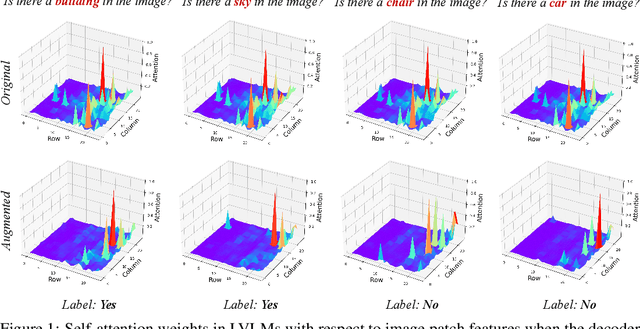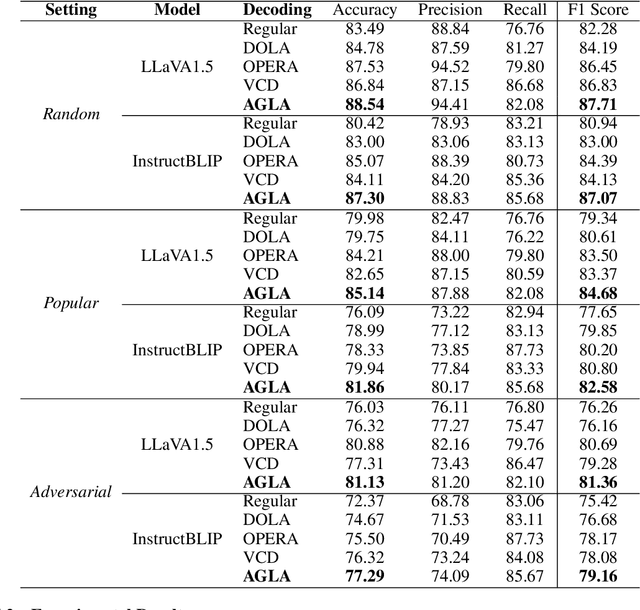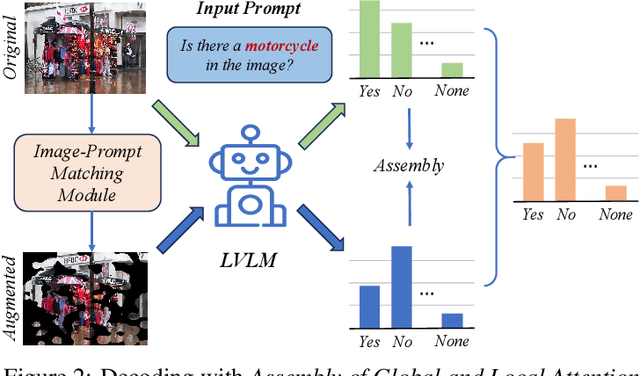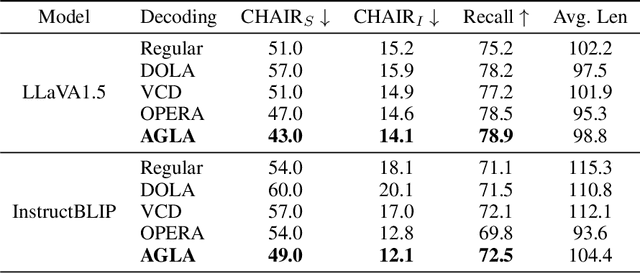Jiahao Nie
Multi-Grained Text-Guided Image Fusion for Multi-Exposure and Multi-Focus Scenarios
Dec 23, 2025Abstract:Image fusion aims to synthesize a single high-quality image from a pair of inputs captured under challenging conditions, such as differing exposure levels or focal depths. A core challenge lies in effectively handling disparities in dynamic range and focus depth between the inputs. With the advent of vision-language models, recent methods incorporate textual descriptions as auxiliary guidance to enhance fusion quality. However, simply incorporating coarse-grained descriptions hampers the understanding of fine-grained details and poses challenges for precise cross-modal alignment. To address these limitations, we propose Multi-grained Text-guided Image Fusion (MTIF), a novel fusion paradigm with three key designs. First, it introduces multi-grained textual descriptions that separately capture fine details, structural cues, and semantic content, guiding image fusion through a hierarchical cross-modal modulation module. Second, it involves supervision signals at each granularity to facilitate alignment between visual and textual features and enhance the utility of auxiliary text. Third, it adopts a saliency-driven enrichment module to augment training data with dense semantic content, further strengthening the cross-modal modulation and alignment. Extensive experiments show that MTIF consistently outperforms previous methods on both multi-exposure and multi-focus image fusion tasks.
CompTrack: Information Bottleneck-Guided Low-Rank Dynamic Token Compression for Point Cloud Tracking
Nov 19, 2025Abstract:3D single object tracking (SOT) in LiDAR point clouds is a critical task in computer vision and autonomous driving. Despite great success having been achieved, the inherent sparsity of point clouds introduces a dual-redundancy challenge that limits existing trackers: (1) vast spatial redundancy from background noise impairs accuracy, and (2) informational redundancy within the foreground hinders efficiency. To tackle these issues, we propose CompTrack, a novel end-to-end framework that systematically eliminates both forms of redundancy in point clouds. First, CompTrack incorporates a Spatial Foreground Predictor (SFP) module to filter out irrelevant background noise based on information entropy, addressing spatial redundancy. Subsequently, its core is an Information Bottleneck-guided Dynamic Token Compression (IB-DTC) module that eliminates the informational redundancy within the foreground. Theoretically grounded in low-rank approximation, this module leverages an online SVD analysis to adaptively compress the redundant foreground into a compact and highly informative set of proxy tokens. Extensive experiments on KITTI, nuScenes and Waymo datasets demonstrate that CompTrack achieves top-performing tracking performance with superior efficiency, running at a real-time 90 FPS on a single RTX 3090 GPU.
Mamba-Adaptor: State Space Model Adaptor for Visual Recognition
May 19, 2025Abstract:Recent State Space Models (SSM), especially Mamba, have demonstrated impressive performance in visual modeling and possess superior model efficiency. However, the application of Mamba to visual tasks suffers inferior performance due to three main constraints existing in the sequential model: 1) Casual computing is incapable of accessing global context; 2) Long-range forgetting when computing the current hidden states; 3) Weak spatial structural modeling due to the transformed sequential input. To address these issues, we investigate a simple yet powerful vision task Adaptor for Mamba models, which consists of two functional modules: Adaptor-T and Adaptor-S. When solving the hidden states for SSM, we apply a lightweight prediction module Adaptor-T to select a set of learnable locations as memory augmentations to ease long-range forgetting issues. Moreover, we leverage Adapator-S, composed of multi-scale dilated convolutional kernels, to enhance the spatial modeling and introduce the image inductive bias into the feature output. Both modules can enlarge the context modeling in casual computing, as the output is enhanced by the inaccessible features. We explore three usages of Mamba-Adaptor: A general visual backbone for various vision tasks; A booster module to raise the performance of pretrained backbones; A highly efficient fine-tuning module that adapts the base model for transfer learning tasks. Extensive experiments verify the effectiveness of Mamba-Adaptor in three settings. Notably, our Mamba-Adaptor achieves state-of the-art performance on the ImageNet and COCO benchmarks.
Unleashing the Potential of Model Bias for Generalized Category Discovery
Dec 17, 2024



Abstract:Generalized Category Discovery is a significant and complex task that aims to identify both known and undefined novel categories from a set of unlabeled data, leveraging another labeled dataset containing only known categories. The primary challenges stem from model bias induced by pre-training on only known categories and the lack of precise supervision for novel ones, leading to category bias towards known categories and category confusion among different novel categories, which hinders models' ability to identify novel categories effectively. To address these challenges, we propose a novel framework named Self-Debiasing Calibration (SDC). Unlike prior methods that regard model bias towards known categories as an obstacle to novel category identification, SDC provides a novel insight into unleashing the potential of the bias to facilitate novel category learning. Specifically, the output of the biased model serves two key purposes. First, it provides an accurate modeling of category bias, which can be utilized to measure the degree of bias and debias the output of the current training model. Second, it offers valuable insights for distinguishing different novel categories by transferring knowledge between similar categories. Based on these insights, SDC dynamically adjusts the output logits of the current training model using the output of the biased model. This approach produces less biased logits to effectively address the issue of category bias towards known categories, and generates more accurate pseudo labels for unlabeled data, thereby mitigating category confusion for novel categories. Experiments on three benchmark datasets show that SDC outperforms SOTA methods, especially in the identification of novel categories. Our code and data are available at \url{https://github.com/Lackel/SDC}.
VoxelTrack: Exploring Voxel Representation for 3D Point Cloud Object Tracking
Aug 05, 2024Abstract:Current LiDAR point cloud-based 3D single object tracking (SOT) methods typically rely on point-based representation network. Despite demonstrated success, such networks suffer from some fundamental problems: 1) It contains pooling operation to cope with inherently disordered point clouds, hindering the capture of 3D spatial information that is useful for tracking, a regression task. 2) The adopted set abstraction operation hardly handles density-inconsistent point clouds, also preventing 3D spatial information from being modeled. To solve these problems, we introduce a novel tracking framework, termed VoxelTrack. By voxelizing inherently disordered point clouds into 3D voxels and extracting their features via sparse convolution blocks, VoxelTrack effectively models precise and robust 3D spatial information, thereby guiding accurate position prediction for tracked objects. Moreover, VoxelTrack incorporates a dual-stream encoder with cross-iterative feature fusion module to further explore fine-grained 3D spatial information for tracking. Benefiting from accurate 3D spatial information being modeled, our VoxelTrack simplifies tracking pipeline with a single regression loss. Extensive experiments are conducted on three widely-adopted datasets including KITTI, NuScenes and Waymo Open Dataset. The experimental results confirm that VoxelTrack achieves state-of-the-art performance (88.3%, 71.4% and 63.6% mean precision on the three datasets, respectively), and outperforms the existing trackers with a real-time speed of 36 Fps on a single TITAN RTX GPU. The source code and model will be released.
Knowledge Acquisition Disentanglement for Knowledge-based Visual Question Answering with Large Language Models
Jul 22, 2024



Abstract:Knowledge-based Visual Question Answering (KVQA) requires both image and world knowledge to answer questions. Current methods first retrieve knowledge from the image and external knowledge base with the original complex question, then generate answers with Large Language Models (LLMs). However, since the original question contains complex elements that require knowledge from different sources, acquiring different kinds of knowledge in a coupled manner may confuse models and hinder them from retrieving precise knowledge. Furthermore, the ``forward-only'' answering process fails to explicitly capture the knowledge needs of LLMs, which can further hurt answering quality. To cope with the above limitations, we propose DKA: Disentangled Knowledge Acquisition from LLM feedback, a training-free framework that disentangles knowledge acquisition to avoid confusion and uses LLM's feedback to specify the required knowledge. Specifically, DKA requires LLMs to specify what knowledge they need to answer the question and decompose the original complex question into two simple sub-questions: Image-based sub-question and Knowledge-based sub-question. Then we use the two sub-questions to retrieve knowledge from the image and knowledge base, respectively. In this way, two knowledge acquisition models can focus on the content that corresponds to them and avoid disturbance of irrelevant elements in the original complex question, which can help to provide more precise knowledge and better align the knowledge needs of LLMs to yield correct answers. Experiments on benchmark datasets show that DKA significantly outperforms SOTA models. To facilitate future research, our data and code are available at \url{https://github.com/Lackel/DKA}.
P2P: Part-to-Part Motion Cues Guide a Strong Tracking Framework for LiDAR Point Clouds
Jul 09, 2024Abstract:3D single object tracking (SOT) methods based on appearance matching has long suffered from insufficient appearance information incurred by incomplete, textureless and semantically deficient LiDAR point clouds. While motion paradigm exploits motion cues instead of appearance matching for tracking, it incurs complex multi-stage processing and segmentation module. In this paper, we first provide in-depth explorations on motion paradigm, which proves that (\textbf{i}) it is feasible to directly infer target relative motion from point clouds across consecutive frames; (\textbf{ii}) fine-grained information comparison between consecutive point clouds facilitates target motion modeling. We thereby propose to perform part-to-part motion modeling for consecutive point clouds and introduce a novel tracking framework, termed \textbf{P2P}. The novel framework fuses each corresponding part information between consecutive point clouds, effectively exploring detailed information changes and thus modeling accurate target-related motion cues. Following this framework, we present P2P-point and P2P-voxel models, incorporating implicit and explicit part-to-part motion modeling by point- and voxel-based representation, respectively. Without bells and whistles, P2P-voxel sets a new state-of-the-art performance ($\sim$\textbf{89\%}, \textbf{72\%} and \textbf{63\%} precision on KITTI, NuScenes and Waymo Open Dataset, respectively). Moreover, under the same point-based representation, P2P-point outperforms the previous motion tracker M$^2$Track by \textbf{3.3\%} and \textbf{6.7\%} on the KITTI and NuScenes, while running at a considerably high speed of \textbf{107 Fps} on a single RTX3090 GPU. The source code and pre-trained models are available at \url{https://github.com/haooozi/P2P}.
Advancing Cross-domain Discriminability in Continual Learning of Vison-Language Models
Jun 27, 2024



Abstract:Continual learning (CL) with Vision-Language Models (VLMs) has overcome the constraints of traditional CL, which only focuses on previously encountered classes. During the CL of VLMs, we need not only to prevent the catastrophic forgetting on incrementally learned knowledge but also to preserve the zero-shot ability of VLMs. However, existing methods require additional reference datasets to maintain such zero-shot ability and rely on domain-identity hints to classify images across different domains. In this study, we propose Regression-based Analytic Incremental Learning (RAIL), which utilizes a recursive ridge regression-based adapter to learn from a sequence of domains in a non-forgetting manner and decouple the cross-domain correlations by projecting features to a higher-dimensional space. Cooperating with a training-free fusion module, RAIL absolutely preserves the VLM's zero-shot ability on unseen domains without any reference data. Additionally, we introduce Cross-domain Task-Agnostic Incremental Learning (X-TAIL) setting. In this setting, a CL learner is required to incrementally learn from multiple domains and classify test images from both seen and unseen domains without any domain-identity hint. We theoretically prove RAIL's absolute memorization on incrementally learned domains. Experiment results affirm RAIL's state-of-the-art performance in both X-TAIL and existing Multi-domain Task-Incremental Learning settings. The code will be released upon acceptance.
AGLA: Mitigating Object Hallucinations in Large Vision-Language Models with Assembly of Global and Local Attention
Jun 18, 2024



Abstract:Despite their great success across various multimodal tasks, Large Vision-Language Models (LVLMs) are facing a prevalent problem with object hallucinations, where the generated textual responses are inconsistent with ground-truth objects in the given image. This paper investigates various LVLMs and pinpoints attention deficiency toward discriminative local image features as one root cause of object hallucinations. Specifically, LVLMs predominantly attend to prompt-independent global image features, while failing to capture prompt-relevant local features, consequently undermining the visual grounding capacity of LVLMs and leading to hallucinations. To this end, we propose Assembly of Global and Local Attention (AGLA), a training-free and plug-and-play approach that mitigates object hallucinations by exploring an ensemble of global features for response generation and local features for visual discrimination simultaneously. Our approach exhibits an image-prompt matching scheme that captures prompt-relevant local features from images, leading to an augmented view of the input image where prompt-relevant content is reserved while irrelevant distractions are masked. With the augmented view, a calibrated decoding distribution can be derived by integrating generative global features from the original image and discriminative local features from the augmented image. Extensive experiments show that AGLA consistently mitigates object hallucinations and enhances general perception capability for LVLMs across various discriminative and generative benchmarks. Our code will be released at https://github.com/Lackel/AGLA.
MMRel: A Relation Understanding Dataset and Benchmark in the MLLM Era
Jun 13, 2024



Abstract:Despite the recent advancements in Multi-modal Large Language Models (MLLMs), understanding inter-object relations, i.e., interactions or associations between distinct objects, remains a major challenge for such models. This issue significantly hinders their advanced reasoning capabilities and is primarily due to the lack of large-scale, high-quality, and diverse multi-modal data essential for training and evaluating MLLMs. In this paper, we provide a taxonomy of inter-object relations and introduce Multi-Modal Relation Understanding (MMRel), a comprehensive dataset designed to bridge this gap by providing large-scale, high-quality and diverse data for studying inter-object relations with MLLMs. MMRel features three distinctive attributes: (i) It includes over 15K question-answer pairs, which are sourced from three distinct domains, ensuring large scale and high diversity; (ii) It contains a subset featuring highly unusual relations, on which MLLMs often fail due to hallucinations, thus are very challenging; (iii) It provides manually verified high-quality labels for inter-object relations. Thanks to these features, MMRel is ideal for evaluating MLLMs on relation understanding, as well as being used to fine-tune MLLMs to enhance relation understanding and even benefit overall performance in various vision-language tasks. Extensive experiments on various popular MLLMs validate the effectiveness of MMRel. Both MMRel dataset and the complete labeling scripts have been made publicly available.
 Add to Chrome
Add to Chrome Add to Firefox
Add to Firefox Add to Edge
Add to Edge